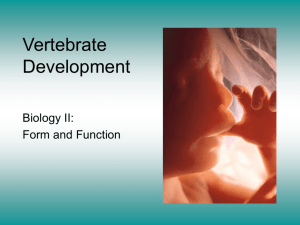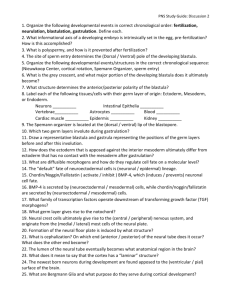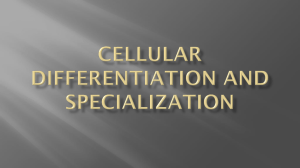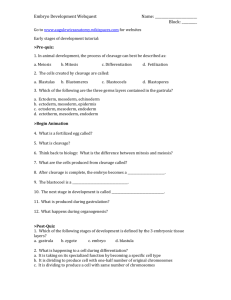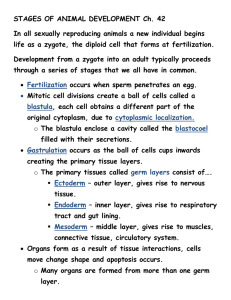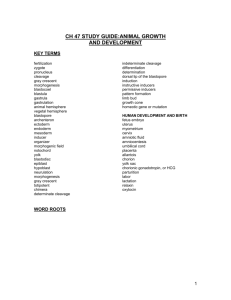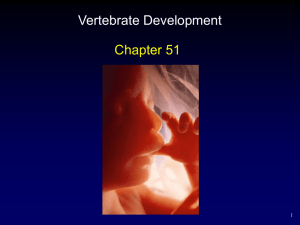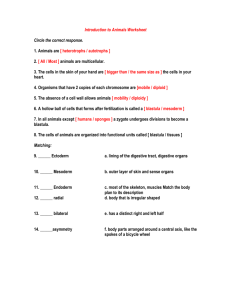Cleavage, blastula, gastrula, neurula
advertisement
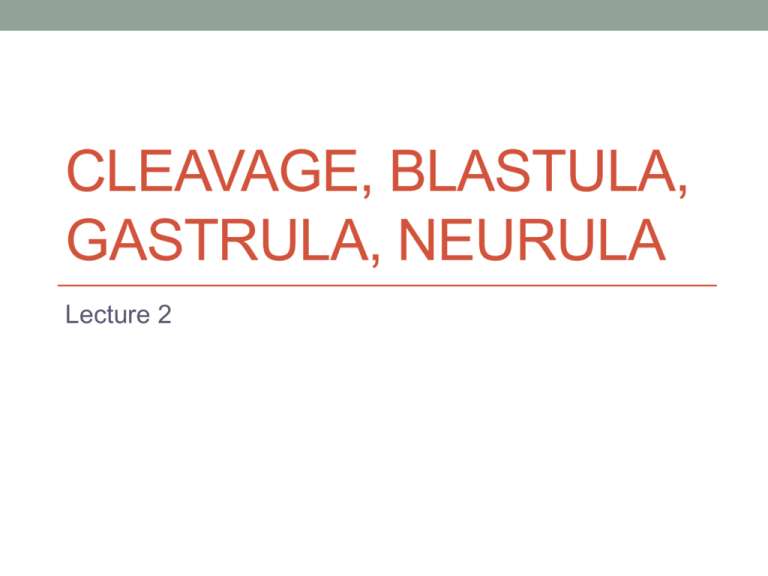
CLEAVAGE, BLASTULA, GASTRULA, NEURULA Lecture 2 Cleavage • Mitosis • Duplication of cells • 1 2 4 8 16 etc. • zygote morula blastula gastrula neurula embryo fetus • Yolk • Contains nutrients for the zygote Cleavage Name Number of cells Zygote Morula Blastula Gastrula 1-8 16-64 128-15,000 >15,000 Neurula Embryo Fetus Neural tube formation Period of organogenesis (2-8 weeks)* Period of growth (2-9 months)* * In humans Distribution of yolk • Oligolecithal (ex. Amphioxus, star fish, sea urchins and mammals) • Eggs with little yolk • Cleavage produces cells of roughly the same size • Mesolecithal (ex. Amphibians) • Moderate amount of yolk • Yolk impedes cleavage formation • Produces cells of unequal size • Holoblastic cleavage • Telolecithal (ex. Reptiles or Birds) • Large amount of yolk • Cell division occurs only at one area • Meroblastic cleavage Amphioxus Cleavage • First division begins at the animal pole • Second division perpendicular to the first • And so on… forming blastomeres. Cleavage in different yolk distributions Blastula formation in Amphioxus • Formation of a fluid filled cavity within the developing embryo, called blastocoele, through a Na+ pump Blastula formation in Amphibians Blastula formation in Birds Blastula formation in Birds Blastula formation in Mammals • Blastula or blastocyst • Similar to initial cleavage in amphioxus or sea urchins, then follows cleavage similar to birds • At the morula stage blastula stage becomes • Process called compaction Morula Stage Blastula Stage Develops into Inner cell mass Embryoblast Embryo proper Outer cell mass Trophoblast Placenta Blastula formation in Mammals Blastula and implantation Blastula formation Formation of Germ layers • Gastrulation = formation of 3 primary germ layers and the primitive gut or archenteron Formation of Germ layers • Mechanisms of Development • Cytoplasmic specification (pre-determined) • Conditional specification (specific development through interactions with the surrounding cells/environment or its position in the developing embryo) • Primary organizer Ectoderm • Outer epithelium of body and derivatives • Hair, nails, epithelial glands, lining of mouth, enamel of teeth, lens of eyes, inner ear, nasal and olfactory epithelium • Neural tube • Brain, spinal cord, motor nerves • Neural crest • Sensory ganglia and nerves, adrenal medulla, sympathetic ganglia, skull, gill arches, dentine of teeth Mesoderm • Notochord vertebrae • Lining of thoracic and abdominal cavities • Circulatory system • Blood, bone marrow, endothelium, lymphatics • Somites • skeleton and muscle, dermis, connective tissue • Urogenital system • Smooth muscle and connective tissue of digestive tract Endoderm • Epithelium of respiratory tract • Pharynx • Epithelium of gut • Liver, pancreas • Inner lining of urinary bladder • Gut tube Gastrulation • Further differentiation into 3 germ cell layers • Formation of the blastopore or primitive streak • Dorsal lip of the blastopore or Spemann organizer • Dominant organizing region of the embryo • Homologous to the Hensen’s node in birds and mammals • Directs differentiation of cells into specific germ layers or organs Gastrulation in Amphioxus Gastrulation in Amphibians Gastrulation in Birds Gastrulation in Birds 1 = Epiblast (forms the ectoderm), 2 = Blastocoel, 3 = Hypoblast (forms the endoderm), 4 = Subgerminal cavity, 5 = Yolk Gastrulation in mammals • Similar to birds • Inner cell mass embryoblast, forms 2 layers • Epiblast forms a cavity amniotic cavity • Epiblast + cytotrophoblast = amnioblast • Hypoblast forms primitive yolk sac • Outer cell mass trophoblast, forms 2 layers • Syncitiotrophoblast secretes beta HCG (human chorionic gonadotropin) • Cytotrophoblast • Forms the placenta Neurula • Neurulation: Formation of the neural tube • Period of development starting with the first traces of formation of the neural plate and ending with the closure of the neural tube • Initiates formation of the central nervous system • Formation of notochord from the endoderm or mesoderm • Acts as initial organizer of the nervous system (stimulates formation of the vertebrae and spinal cord) and creates the basis of the body axis (head and tail) • Eventually disappears and forms the nucleus pulposus in mammals Neurulation • Ectoderm thickens to form the neural plate • Edges of neural plate become raised forming a neural fold, with a depression in the middle, called the neural groove • Anteriorly, neural plate is broadened and flattened • Posteriorly, neural plate becomes narrow and cylindrical Neurula formation in Birds Neurulation • Formation of the neural tube • Neural folds grow and meet each other • Closure begins in the middle and proceeds cephalad and caudad • Formation of the anterior and posterior neuropores, which will eventually close • Mesoderm thickens Nucleus pulposus
